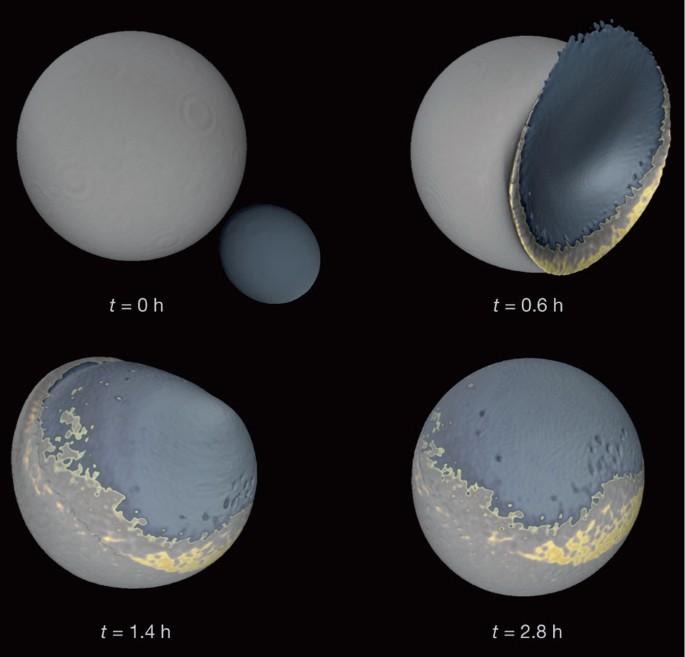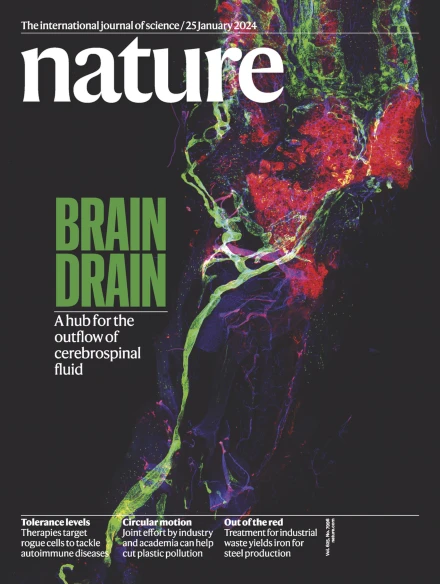Forming the lunar farside highlands by accretion of a companion moon
IF 50.5
1区 综合性期刊
Q1 MULTIDISCIPLINARY SCIENCES
引用次数: 68
Abstract
The Moon is a satellite of two distinct halves. The nearside that faces us all the time is low in altitude, flat and dark in colour, whereas the farside is mountainous and deeply cratered. Martin Jutzi and Erik Asphaug propose that this lunar dichotomy might be the consequence of the late accretion of a companion moon. Companion moons are a common outcome of giant impact and protolunar disk simulations. The new calculations suggest that a collision with a companion at subsonic impact velocity leads to an accretionary pile rather than a crater, resulting in a hemispheric layer consistent with the dimensions and crustal structure of the topography of the farside highlands. The most striking geological feature of the Moon is the terrain and elevation dichotomy1 between the hemispheres: the nearside is low and flat, dominated by volcanic maria, whereas the farside is mountainous and deeply cratered. Associated with this geological dichotomy is a compositional and thermal variation2,3, with the nearside Procellarum KREEP (potassium/rare-earth element/phosphorus) Terrane and environs interpreted as having thin, compositionally evolved crust in comparison with the massive feldspathic highlands. The lunar dichotomy may have been caused by internal effects (for example spatial variations in tidal heating4, asymmetric convective processes5 or asymmetric crystallization of the magma ocean6) or external effects (such as the event that formed the South Pole/Aitken basin1 or asymmetric cratering7). Here we consider its origin as a late carapace added by the accretion of a companion moon. Companion moons are a common outcome of simulations8 of Moon formation from a protolunar disk resulting from a giant impact, and although most coplanar configurations are unstable9, a ∼1,200-km-diameter moon located at one of the Trojan points could be dynamically stable for tens of millions of years after the giant impact10. Most of the Moon’s magma ocean would solidify on this timescale11,12, whereas the companion moon would evolve more quickly into a crust and a solid mantle derived from similar disk material, and would presumably have little or no core. Its likely fate would be to collide with the Moon at ∼2–3 km s−1, well below the speed of sound in silicates. According to our simulations, a large moon/Moon size ratio (∼0.3) and a subsonic impact velocity lead to an accretionary pile rather than a crater, contributing a hemispheric layer of extent and thickness consistent with the dimensions of the farside highlands1,13 and in agreement with the degree-two crustal thickness profile4. The collision furthermore displaces the KREEP-rich layer to the opposite hemisphere, explaining the observed concentration2,3.

伴月吸积形成月球远侧高地
月球是一颗由截然不同的两半组成的卫星。一直面向我们的近侧海拔较低,地势平坦,颜色较深,而远侧则多山,坑坑洼洼。Martin Jutzi 和 Erik Asphaug 提出,月球的这种两面性可能是伴月后期增生的结果。伴月是巨型撞击和原月盘模拟的常见结果。新的计算表明,以亚音速撞击速度与伴星碰撞会导致增生堆而不是陨石坑,从而形成与远侧高地地形的尺寸和地壳结构相一致的半球层。月球最显著的地质特征是半球之间的地形和海拔二分法1 :近边低而平坦,以火山泥灰岩为主,而远边则多山,火山口很深。与这种地质二分法相关的是成分和热量的变化2,3 ,近侧的 Procellarum KREEP(钾/稀土元素/磷)特雷仑和周围地区被解释为与块状长石高地相比,地壳薄、成分演变快。月球二分现象可能是由内部效应(如潮汐加热的空间变化4、不对称对流过程5或岩浆海的不对称结晶6)或外部效应(如形成南极/艾特肯盆地1或不对称陨石坑7的事件)造成的。在这里,我们认为它的起源是由伴星的增生而增加的后期外壳。伴月是模拟8 月球形成的一个常见结果,由巨型撞击产生的原月盘形成,虽然大多数共面配置是不稳定的9,但位于特洛伊点之一的一颗直径为1,200千米的卫星在巨型撞击后的数千万年里可能是动态稳定的10。月球的大部分岩浆海洋将在这一时间尺度上凝固11,12,而伴月会更快地演化成地壳和固体地幔,它们来自于类似的圆盘物质,并且可能只有很少或没有内核。它的命运很可能是以 ∼2-3 km s-1 的速度与月球相撞,远远低于硅酸盐的声速。根据我们的模拟,大的月球/月球尺寸比(∼0.3)和亚音速的撞击速度会导致增生堆而不是陨石坑,形成一个半球形层,其范围和厚度与远侧高地的尺寸1,13一致,并与二度地壳厚度轮廓4相吻合。碰撞还进一步将富含 KREEP 的地层移至对侧半球,从而解释了所观测到的富集现象2,3。
本文章由计算机程序翻译,如有差异,请以英文原文为准。
求助全文
约1分钟内获得全文
求助全文
来源期刊

Nature
综合性期刊-综合性期刊
CiteScore
90.00
自引率
1.20%
发文量
3652
审稿时长
3 months
期刊介绍:
Nature is a prestigious international journal that publishes peer-reviewed research in various scientific and technological fields. The selection of articles is based on criteria such as originality, importance, interdisciplinary relevance, timeliness, accessibility, elegance, and surprising conclusions. In addition to showcasing significant scientific advances, Nature delivers rapid, authoritative, insightful news, and interpretation of current and upcoming trends impacting science, scientists, and the broader public. The journal serves a dual purpose: firstly, to promptly share noteworthy scientific advances and foster discussions among scientists, and secondly, to ensure the swift dissemination of scientific results globally, emphasizing their significance for knowledge, culture, and daily life.
 求助内容:
求助内容: 应助结果提醒方式:
应助结果提醒方式:


